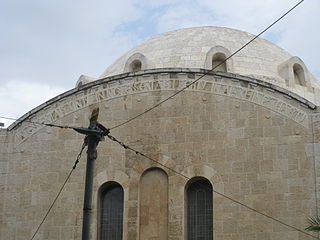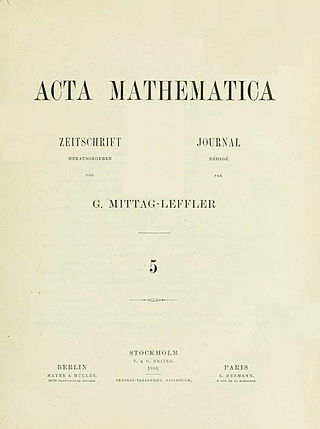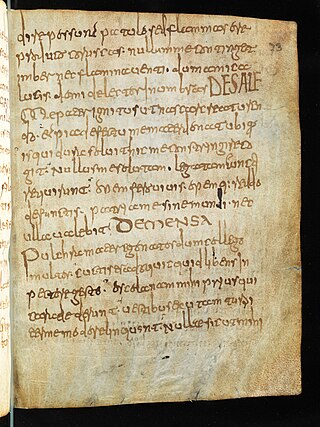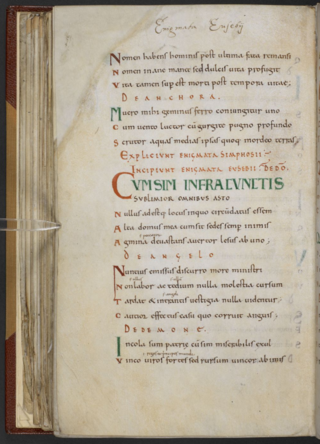Related Research Articles

Boniface, OSB was an English Benedictine monk and leading figure in the Anglo-Saxon mission to the Germanic parts of Francia during the eighth century. He organised significant foundations of the church in Germany and was made bishop of Mainz by Pope Gregory III. He was martyred in Frisia in 754, along with 52 others, and his remains were returned to Fulda, where they rest in a sarcophagus which remains a site of Christian pilgrimage.

The Battle of Espinosa de los Monteros took place during of the Napoleonic Wars, fought on 10 and 11 November 1808 at the village of Espinosa de los Monteros in the Cantabrian Mountains. It resulted in a French victory under Marshal Victor against Lieutenant General Joaquín Blake's Army of Galicia.

Christian August Lobeck was a German classical scholar.

In necessariis unitas, in dubiis libertas, in omnibus caritas is a Latin phrase.

The Douglas C-133 Cargomaster is an American large turboprop cargo aircraft built between 1956 and 1961 by the Douglas Aircraft Company for use with the United States Air Force. The C-133 was the USAF's only production turboprop-powered strategic airlifter, entering service shortly after the Lockheed C-130 Hercules, which is designated a tactical airlifter. It provided airlift services in a wide range of applications, being replaced by the C-5 Galaxy in the early 1970s.

Species Plantarum is a book by Carl Linnaeus, originally published in 1753, which lists every species of plant known at the time, classified into genera. It is the first work to consistently apply binomial names and was the starting point for the naming of plants.
Patricia Briggs is an American writer of fantasy since 1993, and author of the Mercy Thompson urban fantasy series.

Tatwine was the tenth Archbishop of Canterbury from 731 to 734. Prior to becoming archbishop, he was a monk and abbot of a Benedictine monastery. Besides his ecclesiastical career, Tatwine was a writer, and riddles he composed survive. Another work he composed was on the grammar of the Latin language, which was aimed at advanced students of that language. He was subsequently considered a saint.

Mirabilia Urbis Romae is a much-copied medieval Latin text that served generations of pilgrims and tourists as a guide to the city of Rome. The original, which was written by a canon of St Peter's, dates from the 1140s. The text survives in numerous manuscripts.

Acta Mathematica is a peer-reviewed open-access scientific journal covering research in all fields of mathematics.

The Bücker Bü 133 Jungmeister was an advanced trainer of the Luftwaffe in the 1930s. It was a single-engine, single-seat biplane of wood and tubular steel construction and covered in fabric.

mir-133 is a type of non-coding RNA called a microRNA that was first experimentally characterised in mice. Homologues have since been discovered in several other species including invertebrates such as the fruitfly Drosophila melanogaster. Each species often encodes multiple microRNAs with identical or similar mature sequence. For example, in the human genome there are three known miR-133 genes: miR-133a-1, miR-133a-2 and miR-133b found on chromosomes 18, 20 and 6 respectively. The mature sequence is excised from the 3' arm of the hairpin. miR-133 is expressed in muscle tissue and appears to repress the expression of non-muscle genes.

The miR-1 microRNA precursor is a small micro RNA that regulates its target protein's expression in the cell. microRNAs are transcribed as ~70 nucleotide precursors and subsequently processed by the Dicer enzyme to give products at ~22 nucleotides. In this case the mature sequence comes from the 3' arm of the precursor. The mature products are thought to have regulatory roles through complementarity to mRNA. In humans there are two distinct microRNAs that share an identical mature sequence, and these are called miR-1-1 and miR-1-2.
Minuscule 611, α 250, is a Greek minuscule manuscript of the New Testament, on parchment. Palaeographically it has been assigned to the 12th century. The manuscript is lacunose. Formerly it was labeled by 133a and 166p.
Wabamun 133A is a First Nations reserve in central Alberta, Canada, in Division No. 11. It is adjacent to Parkland County on the east shore of Lake Wabamun and is home to the Paul First Nation. The Summer Village of Kapasiwin, the Wabamun 133B Indian reserve, and the Hamlet of Duffield are adjacent to Wabamun 133A to the northwest, north, and east respectively.

Anglo-Saxon riddles are a significant genre of Anglo-Saxon literature. The riddle was a major, prestigious literary form in early medieval England, and riddles were written both in Latin and Old English verse. The pre-eminent composer of Latin riddles in early medieval England was Aldhelm, while the Old English verse riddles found in the tenth-century Exeter Book include some of the most famous Old English poems.

The Bern Riddles, also known as Aenigmata Bernensia, Aenigmata Hexasticha or Riddles of Tullius, are a collection of 63 metrical Latin riddles, named after the location of their earliest surviving manuscript, which today is held in Bern : the early eighth-century Codex Bernensis 611.
The Lorsch riddles, also known as the Aenigmata Anglica, are a collection of twelve hexametrical, early medieval Latin riddles that were anonymously written in the ninth century.

The Enigmata Eusebii are a collection of sixty Latin, hexametrical riddles composed in early medieval England, probably in the eighth century.
References
- Fr. Glorie., ed., Tatvini Opera omnia. Variae collectiones aenigmatum Merovingicae aetatis. Anonymus. De dubiis nominibus. Series: Corpus Christianorum Series Latina, vols. 133-133a. Turnholt: Typographi Brepols, 1968. (BR60 .C49, vols. 133-133A)
- Michael Herren (1989). "Dubiis Nominibus, De". Dictionary of the Middle Ages . Vol-4. ISBN 0-684-17024-8